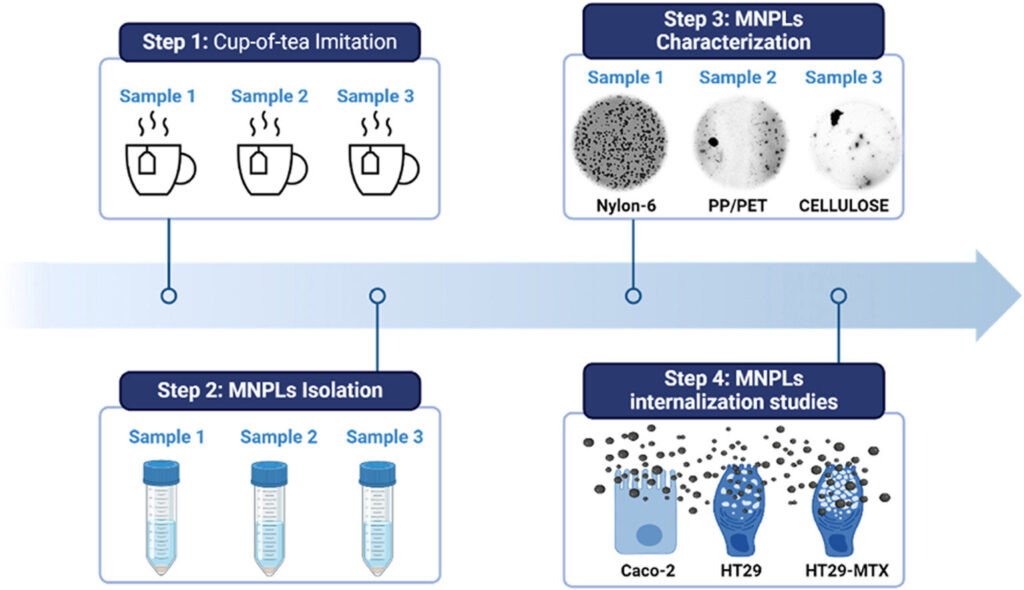UAB research has characterized in detail how polymer-based commercial tea bags release millions of nanoplastics and microplastics when infused. The study shows for the first time the capacity of these particles to be absorbed by human intestinal cells, and are thus able to reach the bloodstream and spread throughout the body.
Plastic waste pollution represents a critical environmental challenge with increasing implications for the well-being and health of future generations. Food packaging is a major source of micro and nanoplastic (MNPLs) contamination and inhalation and ingestion is the main route of human exposure.
A study by the Mutagenesis Group of the UAB Department of Genetics and Microbiology has successfully obtained and characterized micro and nanoplastics derived from several types of commercially available tea bags. The paper is published in the journal Chemosphere.
The UAB researchers observed that when these tea bags are used to prepare an infusion, huge amounts of nano-sized particles and nanofilamentous structures are released, which is an important source of exposure to MNPLs.
The tea bags used for the research were made from the polymers nylon-6, polypropylene and cellulose. The study shows that, when brewing tea, polypropylene releases approximately 1.2 billion particles per milliliter, with an average size of 136.7 nanometers; cellulose releases about 135 million particles per milliliter, with an average size of 244 nanometers; while nylon-6 releases 8.18 million particles per milliliter, with an average size of 138.4 nanometers.
To characterize the different types of particles present in the infusion, a set of advanced analytical techniques such as scanning electron microscopy (SEM), transmission electron microscopy (TEM), infrared spectroscopy (ATR-FTIR), dynamic light scattering (DLS), laser Doppler velocimetry (LDV), and nanoparticle tracking analysis (NTA) were used.
“We have managed to innovatively characterize these pollutants with a set of cutting-edge techniques, which is a very important tool to advance research on their possible impacts on human health,” said UAB researcher Alba Garcia.
Interactions with human cells observed for the first time
The particles were stained and exposed for the first time to different types of human intestinal cells to assess their interaction and possible cellular internalization. The biological interaction experiments showed that mucus-producing intestinal cells had the highest uptake of micro and nanoplastics, with the particles even entering the cell nucleus that houses the genetic material.
The result suggests a key role for intestinal mucus in the uptake of these pollutant particles and underscores the need for further research into the effects that chronic exposure can have on human health.
“It is critical to develop standardized test methods to assess MNPLs contamination released from plastic food contact materials and to formulate regulatory policies to effectively mitigate and minimize this contamination. As the use of plastic in food packaging continues to increase, it is vital to address MNPLs contamination to ensure food safety and protect public health,” the researchers add.
More information:
Gooya Banaei et al, Teabag-derived micro/nanoplastics (true-to-life MNPLs) as a surrogate for real-life exposure scenarios, Chemosphere (2024). DOI: 10.1016/j.chemosphere.2024.143736
Autonomous University of Barcelona
Citation:
Commercial tea bags release millions of microplastics, entering human intestinal cells (2024, December 20)
retrieved 23 December 2024
from https://medicalxpress.com/news/2024-12-commercial-tea-bags-millions-microplastics.html
This document is subject to copyright. Apart from any fair dealing for the purpose of private study or research, no
part may be reproduced without the written permission. The content is provided for information purposes only.


